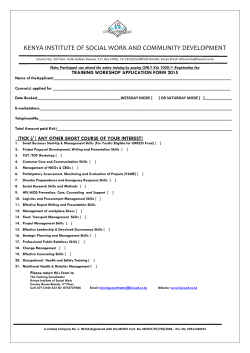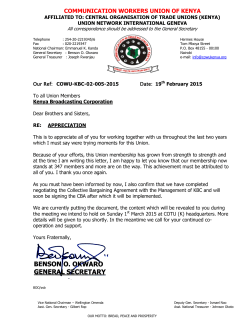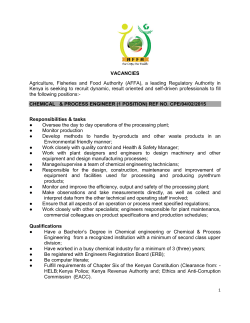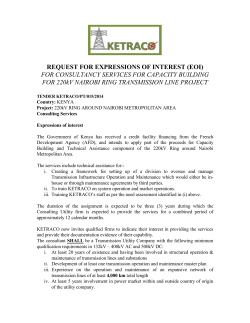
Publication
EVIDENCE BRIEF SEPTEMBER 2014 A STATUS CHECK ON UNINTENDED PREGNANCY IN KENYA STEP UP generates policy-relevant research to promote an evidencebased approach for improving access to family planning and safe abortion. We work in Bangladesh, northern India, Ghana, Kenya, and Senegal. Population Council Coordinating Partner African Population and Health Research Center icddr,b London School of Hygiene and Tropical Medicine Marie Stopes International Partners in Population and Development Funded by Kenya’s mothers are dying at an alarming rate. A woman giving birth in Kenya has a 1 in 38 chance of dying due to inadequate reproductive health services. In response, Kenya’s First Lady Margaret Kenyatta launched the Beyond Zero campaign in 2014 to create awareness and raise funds to tackle maternal mortality and morbidity and improve child health [1]. TOO MANY WOMEN DIE OF PREVENTABLE CAUSES For every maternal death globally, about 30 women suffer from injury due to pregnancy complications, childbirth, or abortion [2]. If every pregnancy, childbirth, and abortion exposes women to a risk of death, then every unintended pregnancy in a high maternalmortality setting such as Kenya, subjects a woman to a life threatening event. Unintended pregnancies can be life-threatening because women reporting them are less likely to receive ante-natal care or to deliver at an appropriate health facility [3]. These women are also more likely to terminate their pregnancies using unsafe procedures. In Kenya, 43 percent of pregnancies are unintended. Therefore, it is not surprising that 14 percent of pregnancies end in abortion and 2,600 women die annually as a result of unsafe abortion in Kenya [4,5]. Indeed, it is estimated that there were 465,000 unsafe abortions procured in Kenya in 2012, resulting in thousands of women suffering from complications from unsafe procedures [6]. Background: Struggling for Critical Reproductive Health Services The new Kenyan Constitution provides fundamental guiding principles which clearly stipulate the right KENYA at-a-GLANCE Average age at first marriage is 20 years for all women. Average age at first intercourse for all women is 18.2 years. Women of reproductive age are having an average of 4.6 children by the end of their reproductive age. 46 percent of females give birth by age 20 years. Modern contraceptive use among married women is 39 percent. Unmet need for contraception among currently married women is 26 percent. 530 women die per 100,000 live births from pregnancy- or childbirth-related causes. Lifetime risk of maternal death is 1 in 38. 43 percent of all pregnancies are unintended (mistimed and unwanted). About 465,000 induced abortions were procured in 2012 among women of reproductive ages (1549 years). 44 percent of all births are attended by skilled personnel. The infant mortality rate is 59 per 1000 live births. 32 percent of children are exclusively breastfed during the first 6 months of life. for Kenyans to have access to quality reproductive health care services. Though essential strides have been made in relation to reducing maternal mortality and morbidity from childbirth and unsafe abortion, Kenyan women needing such services still face barriers, including low quality health care services, bureaucracy, and lack of public information. Kenya reproductive health indicators remain poor, with high levels of unintended pregnancies, unsafe abortions, and lack of access to health services especially by adolescents, youth and other vulnerable populations such as poor women with no education and those living in rural or poor urban areas. The urgent need for more sexual and reproductive health services and commodities in Kenya is only expected to significantly increase over time. If fertility rates remained the same as they are today, the proportion of women within reproductive age will grow by 8 percent by 2040. Although significant barriers exist, there are simple and effective ways to reduce the number of unintended pregnancies in Kenya. For example, it is estimated that meeting the unmet need for family planning in Kenya would reduce the number of unintended pregnancies by nearly 4 million by 2015, leading to 1.3 million fewer abortions and nearly 2.1 million fewer unintended births [7]. Further, if Kenyan women were to achieve their desired fertility, they would have 1.4 fewer children on average. Unintended Pregnancy in Kenya: A Country Profile The Unintended Pregnancies in Kenya: A Country Profile report provides a comprehensive analysis of a wide range of factors associated with unintended pregnancy in Kenya and documents changes in family planning and reproductive health indicators since the early 1990s [1993-2009] [8]. The major report findings include: Family Planning and Reproductive Health Indicators: Trend and Equity Analysis The current rate of contraceptive usage has modestly increased over the 15 years examined, particularly for women older than 24 years. The uptake of long acting methods (e.g., implants) remains very low and has declined for methods such as the IUD. Levels of unmet need for family planning have changed little over time, especially among currently married women. Levels of unintended pregnancy among Kenyan women have changed little over the last 5 years, declining from 45 percent in 2003 to just 43 percent in 2008/09. It is estimated that meeting the unmet need for family planning in Kenya would reduce the number of unintended pregnancies by nearly 4 million by 2015, leading to 1.3 million fewer abortions and nearly 2.1 million fewer unintended births. Contraceptive discontinuation rates remain high with 1 in 3 couples discontinuing a method in the first 12 -24 months of use. Health concerns or contraceptive side effects were the most commonly cited reason for non-use of contraception. Although contraceptive use among 15-24 year olds has increased modestly, about 47 percent of pregnancies among female youth are unintended. About 465,000 induced abortions were procured in 2012 among women of reproductive ages (15-49 years) in Kenya, indicating an annual abortion rate of 48 per 1000 women. Access to and Quality of Family Planning and Abortion-related Services About 85 percent of public and private facilities assessed in Kenya provide modern family planning as of 2010, though regional variations exist. Temporal methods are more commonly available in health facilities while long acting and permanent methods are available in less than 10 percent of the facilities assessed. In 2010, only 25 percent of the facilities offering temporary methods of family planning had all necessary items (including a private room or a visual barrier, individual client cards, written guidelines for family planning and visual aids for family planning) to support quality counselling. Although government-supplied commodities are free, user fees are often charged for family planning services. Public facilities are more likely to provide free family planning services. The proportion of facilities where staff report routine training on family planning service provision remains low, with only 23 percent of facilities reporting any training of staff in the last twelve months in 2010. There are substantial disparities in the quality of postabortion care service provision by region, type of facility and cadre of health care provider. Although mifepristone and misoprostol are registered for reproductive health use, medical abortion remains limited and is not widely used by practitioners and providers or known by the women needing these services. Financing and Delivery Mechanisms Seventy-five to eighty percent of the total reproductive health/family planning service delivery related costs are met by the government through provision of personnel, facilities, and other infrastructure and support activities. Frequent contraceptive stock-outs continue to occur because of high reliance on donor financing of commodity procurement and weak logistics and distribution systems. The commercial/private sector increasingly plays a role in the provision of family planning services and currently provides about 35 percent of family planning services in Kenya. The reproductive health voucher system remains a vital financing mechanism and safety net for low-income populations. It also serves as a financial incentive to health facilities to properly attend to low-income women. The National Health Insurance Fund (NHIF – public health insurance) is an important agent in family planning and reproductive health financing and will have a wider reach if it is expanded to include the non-formal sector. Policy Recommendations: Ensuring Essential Maternal and Reproductive Health Services The following six policy and programmatic recommendations address significant sexual and reproductive health challenges highlighted throughout the report. These recommendations take into account the policy context in Kenya, which is evolving at a rapid rate in part because of the new devolution process, and increased interest and public debate surrounding maternal health and family planning. Overall, it is expected that the recommendations outlined below provide promising approaches to: 1) reduce unintended pregnancy; and 2) prevent unsafe abortion: Ministry of Education, Ministry of Health and County Departments of Health should accelerate the implementation of the relevant policies and guidelines (such as the National School Health Policy, the Adolescent Reproductive Health and Development Policy, and the 2005 National Guidelines for Provision of Youth Friendly Services in Kenya) to reach youth with comprehensive sexual and reproductive health information and services. The County Departments of Health and the newly appointed County National Council for Population and Development Representatives should develop comprehensive communication and sensitization approaches that address local context-specific concerns about the use of contraception. © APHRC The National Partnership for the Prevention of Maternal Mortality and associated organizations such as the Reproductive Health Alliance should coordinate comprehensive awareness campaigns to expand communication on laws, policies, and reproductive health services and rights that are allowed under the constitution. The Ministry of Health should expand the free maternal health care package services to include family planning services. County government health departments should assess the feasibility of Public-Private Partnerships (PPPs) as an avenue to deliver quality sexual and reproductive health services The Ministry of Health, the Reproductive Health Network, and the National Partnership for the Prevention of Maternal Morbidity and Mortality should improve access to quality post-abortion care services (including reducing financial barriers to accessing care), and improve the quality of post-abortion care in both public and private health facilities. An Innovative Approach to Comprehensive Sex Education for In-School Youth One idea for an alternative model to reach in-school youth is the use of health care professionals such as nurses and counselors and or specially trained Community Health Workers (CHWs) who are assigned and/or placed in schools to provide SRH classes and ad-hoc counseling. This approach would relieve teachers from having to take on SRH education, a concern that they have raised and would place the responsibility of sexual education on properly trained experts. CONCLUSION Levels of unintended pregnancies remain a great challenge in Kenya. Though the Kenyan government has made key strides in improving reproductive health outcomes for its citizens, the recommendations outlined in the report would help the country move closer to achieving its reproductive health goals. REFERENCES 1. Charles Gacheru: Why I’ll be running with Kenya’s First Lady this weekend. Daily Nation Nairobi Accessed January 31, 2014: http://www.nation.co.ke/ lifestyle/women/-running--First-Lady-this-weekend//1950830/2167856/-/1950397l1950832nz/-/index.html. 2. World Health Organization: Disease and injury country estimates: Burden of Disease. In.: World Health Organization; 2004. 3. Fotso J, Ezeh A, Madise N, Ziraba A, Ogollah R: What does access to maternal care mean among the urban poor? Factors associated with use of appropriate maternal health services in the slum settlements of Nairobi, Kenya. Maternal and Child Health Journal 2009, 13(1):130-137. 4. Hussain R: Abortion and unintended pregnancy in Kenya. In. Edited by Institute AG, vol. In Brief, No 2. New York: Guttmacher Institute; 2012. 5. Kenya National Bureau of Statistics (KNBS), ICF Macro: Kenya Demographic and Health Survey 2008-09. Calverton, Maryland: KNBS and ICF Macro; 2010. 6. African Population and Health Research Center, Ministry of Health (MOH) K, Ipas, Institute G: Incidence and Complications of Unsafe Abortion in Kenya: Key Findings of a National Study. Nairobi, Kenya. APHRC, Ministry of Health (MOH), Kenya, Ipas, and Guttmacher Institute; 2013. 7. USAID: Achieving the Millennium Development Goals: The Contribution of Fulfilling the Unmet Need for Family Planning. USAID; 2006 8. Mumah,J, Kabiru, CW, Mukiira C, Brinton, J, Mutua, M, Izugbara, C, Birungi, H, Askew, I: Unintended Pregnancies in Kenya: A Country Profile: STEP UP Research Report. Nairobi: African Population and Health Research Center. 2014 SUCCESS STORY UNFPA and Sensitizing Religious Communities on Family Planning In 2012, UNFPA developed a collaborative intervention with Islamic religious leaders to address contraceptive uptake among Islamic communities. The program included a three-day national dialogue aimed at sensitizing religious leaders about population issues, addressing myths about family planning within the context of Islam, and developing context-appropriate and culturally-sensitive messages to increase demand of contraceptives and reproductive health services. Following this meeting, the religious leaders developed key advocacy messages that have since been in use by religious leaders in their communities. UNFPA Annual Report, 2012. http://countryoffice.unfpa. org/kenya/drive/UNFPAAnnualReport2012.pdf Suggested citation: Mumah, J, Brinton, J, Kabiru, CW, Mukiira C, Izugbara, C. 2014. “Kenya Country Profile: A Status Check on Unintended Pregnancy,” STEP UP Evidence Brief, August 2014. Nairobi: African Population and Health Research Center. www.stepup.popcouncil.org © 2014 APHRC.
© Copyright 2025









